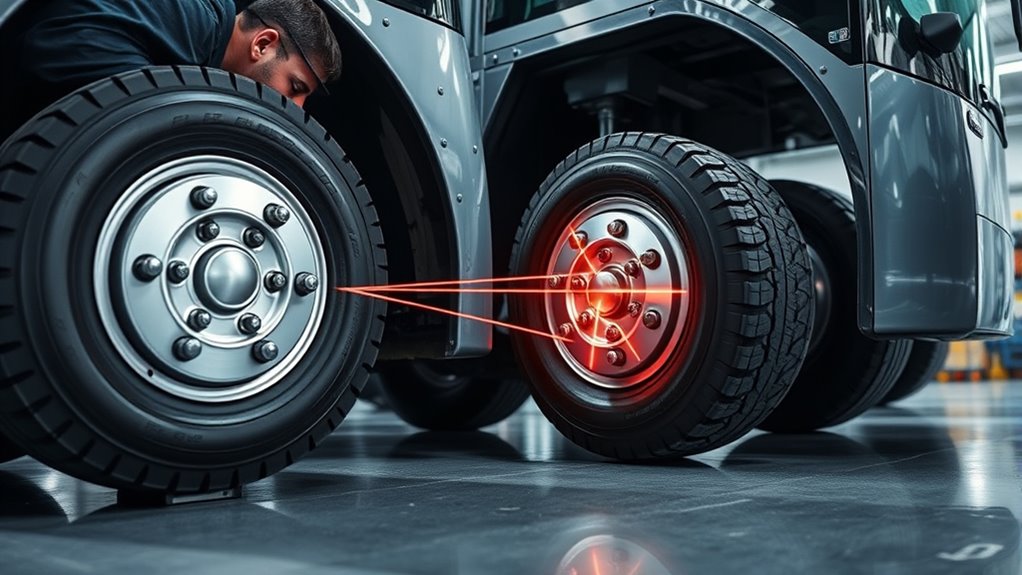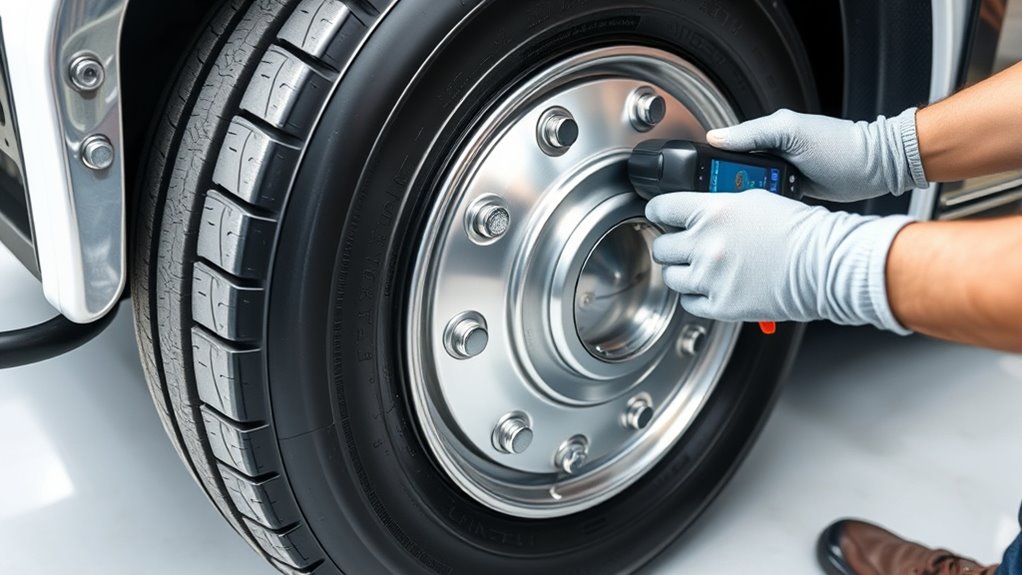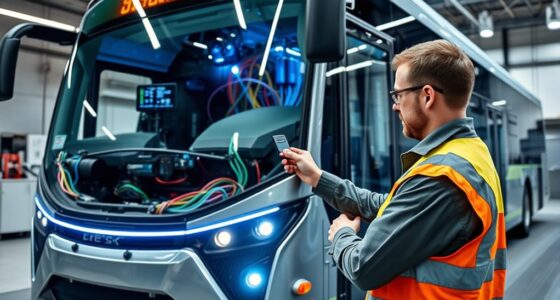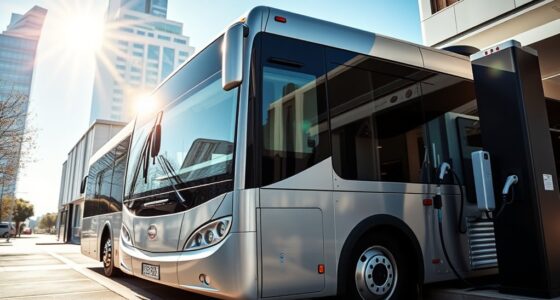To properly align electric bus tires, start by verifying the vehicle’s ride height and inspect the suspension, steering, and tires for wear or damage. Use advanced electronic alignment equipment to measure camber, caster, and toe angles, adjusting the rear wheels first, then the front, to guarantee they match manufacturer specifications. Remember to take into account the bus’s weight distribution, especially the batteries, for maximum efficiency and safety. Continue exploring these steps to master precise alignment techniques.
Key Takeaways
- Verify suspension integrity, ride height, and tire condition before alignment to ensure accurate results.
- Use advanced electronic alignment equipment and secure wheel turntables for precise measurements.
- Adjust rear axle first, focusing on camber, caster, and toe angles specific to electric bus weight distribution.
- Ensure front wheels are aligned to the thrust line for straight driving and optimal handling.
- Conduct regular alignment checks, especially after rough roads or significant maintenance, to maintain safety and efficiency.

Proper tire alignment is essential for maintaining the safety, efficiency, and longevity of electric buses. When you keep the wheels properly aligned, you ensure even tire wear, which reduces the risk of blowouts and uneven tread deterioration. It also improves vehicle stability, making your electric bus safer to operate, especially during turns or sudden maneuvers.
For electric buses, precise alignment is even more critical because it directly impacts range and energy efficiency. Misaligned tires increase rolling resistance, causing the vehicle to consume more power and decrease its operational efficiency. Additionally, high-quality alignment equipment enhances the accuracy and reliability of the adjustments, leading to better maintenance outcomes. Maintaining proper wheel alignment can also prevent premature suspension component wear, saving costs over time.
To achieve the best results, you should start with a four-wheel alignment, which is the most accurate method, especially for vehicles with adjustable rear suspension. During the process, key adjustments are made to camber, caster, and toe angles. Camber refers to the tilt of the wheels inward or outward, caster controls steering wheel stability, and toe adjusts the direction the wheels point. Properly setting these angles ensures that the tires wear evenly and the bus maintains ideal handling.
Before beginning any alignment work, you must perform pre-alignment checks. Verify the ride height to confirm it’s within manufacturer specifications, and inspect the suspension system for wear or damage. Check the tires for uneven wear or damage, as these issues can skew alignment results. Also, inspect the steering system for any play or issues that could affect accuracy. Moreover, ensuring the balance of the wheels is correct can help achieve more precise alignment results. Properly balanced wheels reduce vibrations that can interfere with accurate measurements. In addition, considering the weight distribution of electric buses can help optimize the alignment for maximum efficiency and safety.
Make sure the vehicle is correctly positioned on the alignment rack, centered, and stable, so measurements are precise. Using advanced equipment makes the process more accurate. Electronic alignment machines measure wheel angles and provide real-time feedback via computer readouts, guiding adjustments. Turntables secure the vehicle’s wheels, allowing for precise measurement and adjustment.
After initial measurements, adjustments are made to the rear axle first, followed by the front wheels. The goal is to align the front wheels to the rear wheels’ thrust line, ensuring the vehicle moves straight without pulling. Once adjustments are complete, the steering wheel should be centered, confirming proper alignment.
Electric buses have unique considerations because of their weight distribution, which is affected by large batteries. These weight differences can change camber and beam settings, especially on the rear wheels, to maximize efficiency. Proper alignment in electric vehicles enhances range, reduces tire wear patterns caused by torque, and ensures compliance with local regulations. Regular checks are recommended during routine maintenance, especially after rough road conditions or mileage intervals specified by the manufacturer. Using diagnostic tools early can help detect misalignment issues before they cause significant tire wear or reduce efficiency.
Frequently Asked Questions
How Often Should Electric Bus Tires Be Realigned?
You ask how often to realign electric bus tires. Typically, you should check and align them twice a year, especially if the bus operates on rough routes or carries heavy loads.
Be alert for signs like uneven wear, steering issues, or vibrations. Regular pre-trip inspections and monitoring tire wear help catch problems early, ensuring safety, efficiency, and extending tire life.
Always follow the manufacturer’s specific recommendations for your bus model.
Can Electric Bus Tire Alignment Be Done During Operation?
Imagine you’re inspecting an electric bus after hitting a pothole. You might wonder if you can perform tire alignment during operation. The answer is no—you can’t.
Alignment requires the vehicle to be stationary, with specialized tools measuring angles precisely. Operating the bus during alignment isn’t feasible, as it demands a static setup to guarantee accuracy and safety.
Regular scheduled checks are essential for peak performance.
What Signs Indicate Misalignment in Electric Bus Tires?
You’re wondering how to tell if your electric bus tires are misaligned. Look for uneven tire wear, which shows inconsistent contact with the road.
Notice if the steering wheel feels crooked or off-center, or if the vehicle pulls to one side.
Feel for vibrations, listen for squealing noises, or observe if the bus vibrates at high speeds.
These signs indicate your tires may need realignment to guarantee safe, efficient driving.
Are Special Tools Needed for Electric Bus Tire Alignment?
You wonder if you need special tools for electric bus tire alignment. Yes, you do. To guarantee precise adjustments, you’ll use alignment machines with sensors and cameras, which accurately measure camber, caster, and toe angles.
Turntables and racks help position the bus correctly, while computer software compares measurements to specifications. These specialized tools are essential for achieving the exact alignment needed for electric buses’ unique chassis and suspension requirements.
Does Tire Alignment Improve Electric Bus Energy Efficiency?
You might think tire alignment doesn’t matter much—after all, it’s just about wheels, right? But surprisingly, proper alignment actually boosts your electric bus’s energy efficiency by reducing rolling resistance and uneven tire wear.
When you keep those tires aligned, you save energy, extend tire life, and cut operational costs. It’s a small step with a big impact, turning simple maintenance into a powerful efficiency booster.
Conclusion
Now that you know how to properly align electric bus tires, you’re well on your way to ensuring safety and efficiency. Remember, a well-aligned tire isn’t just about smooth rides; it’s about extending tire life and reducing maintenance costs. Don’t wait until things go south—stay proactive and keep everything in check. When it comes to tire alignment, it’s better to be safe than sorry and catch issues before they become major headaches.









